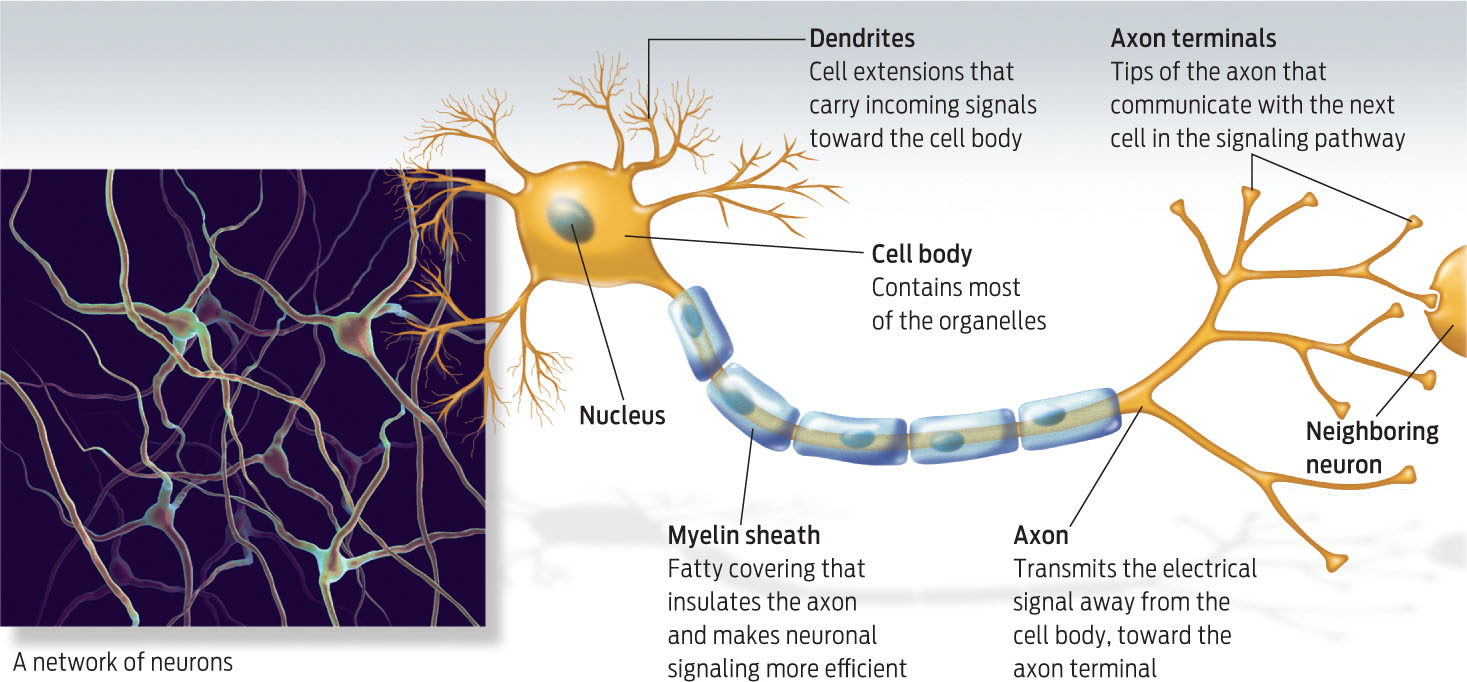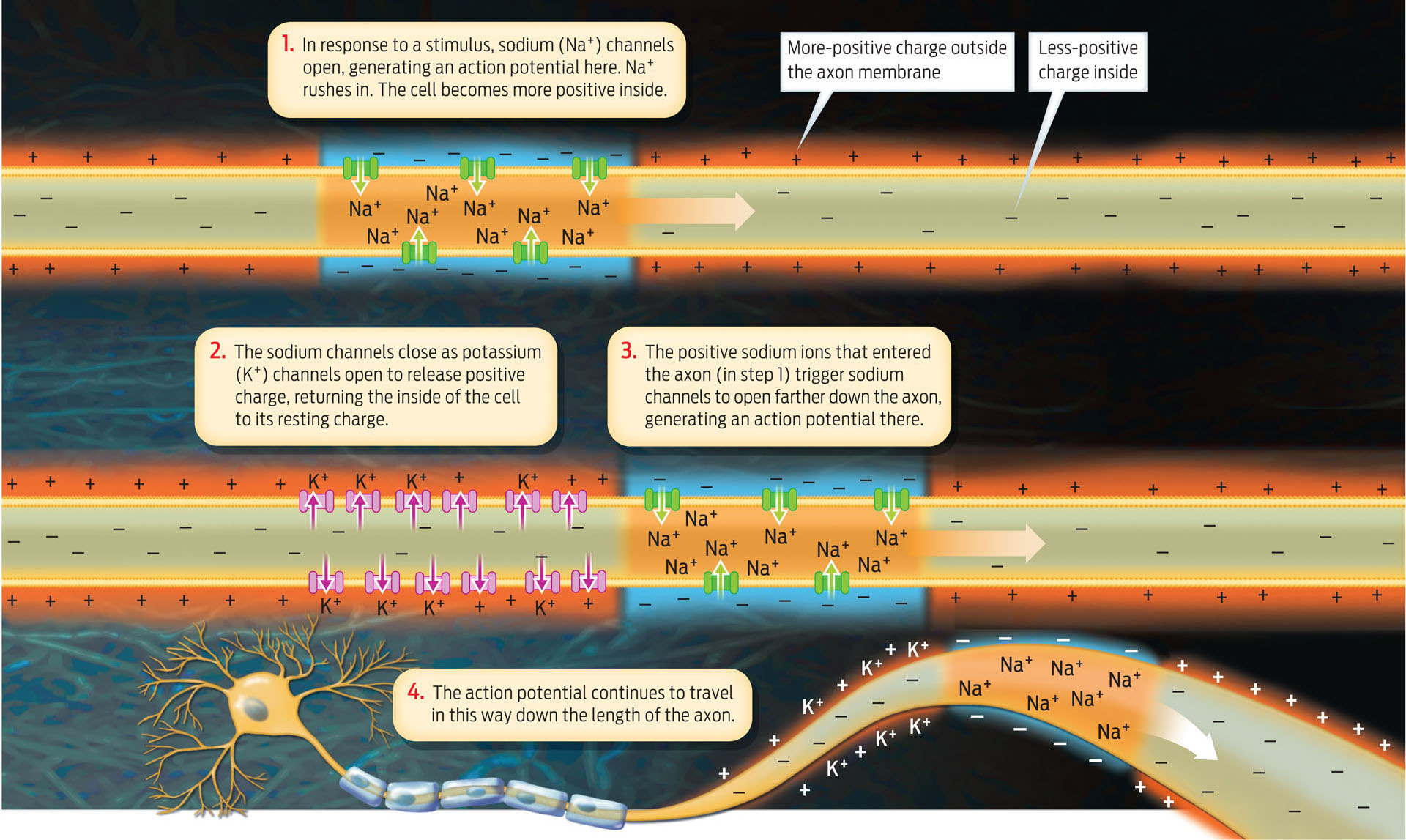EXCITABLE CELLS
NEURONS Specialized cells of the nervous system that generate electrical signals in the form of action potentials.
Addiction is a complex psychological and physiological process that affects many parts of the nervous system, but it begins at the level of the cell. Fundamentally, the brain–like any organ–is a collection of cells. The cells of the brain are organized into networks that receive, process, and send information. Highly specialized cells called neurons are the individual units of this elaborate network.
CELL BODY The part of a neuron that contains most of the cell’s organelles, including the nucleus.
647
DENDRITES Branched extensions from the cell body of a neuron, which receive incoming information.
Neurons have a unique structure that enables them to send and receive signals: a neuron consists of a large cell body with branched extensions called dendrites that receive signals and a single large axon that carries signals away from the neuronal cell body. The end of the axon, called the axon terminal, transmits the signals to the next cell in the network, which could be another neuron, a muscle cell, or an endocrine cell (INFOGRAPHIC 29.3).
AXON The long extension of a neuron that conducts action potentials away from the cell body toward the axon terminal.
AXON TERMINAL The tip of an axon, which communicates with the next cell in the pathway.
Neurons, the highly specialized cells of the nervous system, have a structure that enables them to send and receive electrical signals quickly.

SENSORY NEURONS Cells that convey information from both inside and outside the body to the CNS.
MOTOR NEURONS Neurons that control the contraction of skeletal muscle.
There are different types of neuron. Sensory neurons, such as sensory receptors in the eyes or skin, receive information from the external world and transmit it to the CNS. Motor neurons transmit information from the CNS to muscle cells, signaling them to contract or relax.
ACTION POTENTIAL An electrical signal within a neuron caused by ions moving across the cell membrane.
The signals sent along a neuron are electric currents. Dendrites and axons are like electrical cords that help collect and transmit information in the nervous system. In fact, a nerve is just a bundle of axons of neurons. The axon of a single motor neuron can be over a meter long.
Neurons can conduct electrical signals because of the special properties of their cell membrane. Like other cells in the body, neurons have a slight difference in electrical charge across the membrane: the inside of the neuron has a negative charge relative to the charge outside the cell. But unlike most other cells, neurons can dramatically change the charge difference across the membrane, resulting in an electrical signal. Ion channels in the axon membrane open and close to allow specific ions to cross. When axons of neurons allow positive ions to cross the cell membrane, the charge across the membrane changes. This sudden change of charge initiates an action potential, a coordinated pattern of ion flow across the membrane that is conducted down an axon. Like the fuse leading to a stick of dynamite, an action potential firing at one point along an axon can “ignite” an action potential farther along the axon, and the electrical signal is transmitted down the length of the axon (INFOGRAPHIC 29.4).
Neurons conduct electrical signals called action potentials, which are generated as ions flow across the cell membrane. When a neuron “fires”, sodium (Na+) and potassium (K+) ions enter and leave the axon in a characteristic pattern, creating an action potential. In an axon the firing of an action potential triggers the firing of another farther down the axon. In this way, signals pass along the axon.

648
MYELIN A fatty substance that insulates the axons of neurons and facilitates rapid conduction of action potentials.
Action potentials travel down the length of a neuron very quickly. Just think how quickly your arm moves in response to touching a hot stove–the movement seems almost instantaneous; an action potential can last for less than 1 millisecond.
GLIAL CELLS Supporting cells of the nervous system.
Electrical signals can travel so quickly down neurons because, much like an electrical cord, neurons are insulated: they are coated with a sheath of myelin that wraps around the axon at repeating intervals and prevents the electrical charge from leaking across the membrane. Myelin speeds nerve transmission by allowing electrical charges to spread more quickly down the axon. Because ion channels open only at unmyelinated regions, action potentials appear to hop from one unmyelinated region of the axon to another, and it takes fewer action potentials to conduct the signal down the length of the axon. Myelin is critical to nerve transmission: without it, action potentials weaken, losing strength as they pass along the axon, and can peter out before reaching the axon terminal. Diseases in which myelin degenerates over time, such as multiple sclerosis, can cause progressive paralysis, primarily because motor neurons lacking myelin can’t efficiently conduct electrical signals and ultimately can’t transmit those signals to muscles. The myelin sheath is produced by a type of supportive cell called a glial cell.
649